Abstract
Once a reinforced concrete (RC) structure is damaged by fire, the fire damage assessment should proceed to take appropriate post-fire actions, including the decision-making of whether it can be repaired for reuse or not. Since the assessment results of current fire damage diagnosis methods, however, highly depend on the subjective judgment of inspectors, it is hard to ensure their objectiveness and reliability. This study, therefore, aims to develop a new fire damage diagnosis system (FDDS) based on fuzzy theory that can provide objective and comprehensive evaluation results by considering all of the damage conditions observed from the inspection on RC structural members exposed to fire. In addition, the FDDS was applied to an actual fire-damaged case reported by the Architectural Institute of Japan (AIJ, 2009), and it appears that the proposed method provides a reasonable estimation on the fire damage grade of the fire-damaged RC members.
1. Introduction
The fire damage levels of reinforced concrete (RC) structures significantly depend on the size and duration of the fire [,]. If the fire is small and short, the damage is likely to be small in a limited range of the concrete members. If the concrete structure is exposed to high temperatures for a long time, however, the damage is likely to be severe in a large number of the concrete members, resulting in significant reductions in their strength and durability performances, which thus threatens the safety of the whole structure [,,]. In particular, if spalling occurs to high-strength concrete columns exposed to high temperatures, their reduced cross-section can lead to the stiffness and strength degradations of the whole structure and can even cause the collapse of the structure. To determine the appropriate repairing or strengthening method for the RC structures after fire accidents, it is very important to accurately and rapidly diagnose their fire damage levels. According to the fire damage diagnosis methods presented in the Korea Concrete Institute (KCI) [] and the Architectural Institute of Japan (AIJ) [], the fire damage levels of RC structures are evaluated by five grades, as shown in Table 1, based on the simple visual inspection or the detailed investigations on the fire-damaged concrete members. The diagnosis results, however, highly depend on the experience and knowledge of the inspector; it is hard to ensure their objectiveness and reliability.

Table 1.
Fire damage grades [,].
Fuzzy theory has been widely adopted in various modern engineering fields to solve many complex problems [,], where many influencing factors need to be considered with large uncertainties, and theoretical or numerical solutions are not available or at least difficult to find. Fuzzy theory has been also utilized for many decision-making procedures in the civil engineering fields [,,,,,]. For instance, Rao et al. [] and Mo et al. [] applied fuzzy theory for the optimization of their structural or engineering design. Kim et al. [,] introduced a fuzzy-based assessment method to estimate the durability and serviceability performances of reinforced concrete buildings and also developed the crack diagnosis system that can identify the primary causes of cracks. Cho et al. [] developed the remaining service life evaluation method of concrete buildings by utilizing fuzzy theory, which can consider the effects of multiple influencing factors on the deterioration of durability. Cho et al. [] also estimated the carbonation depth of a reinforced concrete member using the adaptive neuro-fuzzy inference system, in which the field inspection data had been trained to consider the combined deterioration by multiple influencing factors. All of these systems aid us to diagnose or solve the various engineering problems at the level of an expert. There has been, however, yet no study that utilizes fuzzy theory for the fire damage assessment. In this study, therefore, fuzzy theory was utilized to establish the fire damage diagnosis system (FDDS) that can comprehensively consider the various influencing factors and also objectively evaluate the fire damage levels of RC members.
2. Previous Research
2.1. Fire Damage Inspection
As shown in Table 1, the fire damage diagnosis methods presented in the KCI and AIJ specifications [,] divide the fire damage levels into five grades. This classifies the structural members exposed to a fire below 300 °C, having no or marginal fire damage into the non-structural finishing materials, as Grades I or II, respectively. The case where the structure is exposed to an intermediate level of a fire ranging from 300 °C to 600 °C and micro cracks and small spalling damages are observed in column members can be classified into Grade III. When the structure is exposed to a relatively high temperature ranging from 600 °C to 950 °C, having many large cracks and partial exposure of steel bars, it is included in Grade IV. The case where the structure is exposed to a very high temperature exceeding 950 °C, having severe member deformation and large cracks, as well as heavy exposure of steel bars in a wide area, is classified as Grade V. Thus, as indicated by the fire damage diagnosis methods presented in the KCI and AIJ specifications, the heating temperatures of the members is the critical factor to determine the fire damage grades of RC structural members [,,].
As shown in Table 2, the fire damage inspections are conducted through the primary and secondary investigations. In the primary field inspection, concrete discoloration, cracks, spalling and peeling are visually observed, and it is then determined whether the fire damage level can be categorized as Grade I or not. If not, a secondary investigation needs to be done through non-destructive tests, mechanical tests, material sample examinations, analytical methods, etc. The conventional fire damage diagnosis method, however, has shortcomings in that it is difficult to consider the field inspection results in a comprehensive and synthetic manner, and consequently, the fire damage grade is determined strongly depending on the subjective judgment of the inspector. Therefore, this study proposed the FDDS based on fuzzy theory that can provide the fire damage grades in a reasonable and systematic manner.

Table 2.
Checklist for fire inspection [,].
2.2. Fuzzy Theory
As previously mentioned, fuzzy theory is often used to solve complex engineering problems that involve multiple and inter-dependent influencing factors with large uncertainties. In particular, it is possible to numerically quantify uncertain variables through fuzzification []. Fuzzification is the process that assigns a fuzzy value to a crisp value through a membership function, where the fuzzy value () can be expressed as follow:
where is the crisp value, is the degree of membership on the variable and the subscript stands for a fuzzy set that is composed of the fuzzy values (). The fuzzy set plays an important role in fuzzy theory, such as the fuzzy inference, the fuzzy measure and the fuzzy integral. In addition, the fuzzy sets are also used to compose fuzzy rules that define the correlation between the input and output variables []. In this study, as shown in Figure 1, the fuzzification was performed on the input variables of concrete discoloration, crack width, spalling, etc., and the fire damage grades were estimated through the fuzzy inference approach.

Figure 1.
Visual inspection and experimental investigation.
2.3. Fuzzy Inference
Fuzzy inference [] is a method for estimating the comprehensive results using given datasets by approximate reasoning through the fuzzification of a general conditional proposition into a fuzzy conditional proposition defined as fuzzy sets. Among the fuzzy inference methods, the min-max method proposed by Mamdani [,] was adopted in this study. Mamdani’s fuzzy inference system has been widely used to take advantages of its simple reasoning approach and easy graphical expression. Figure 2 shows an example for better understanding of the fuzzy inference system utilized in this study, in which two fuzzy rules (the fuzzy Rules 1 and 2) were introduced. In this example, , which is the membership degree of the output value in the output fuzzy set , can be expressed as a function of the two membership degrees and of the input values and in the input fuzzy sets and , respectively, based on the min-max method, as follows:
where and ranges from 1 to and , respectively, and are the number of the input and output fuzzy sets, respectively, is the number of the fuzzy rules and and are the maximum and minimum calculation operators, respectively. As expressed in Equation (2), the output fuzzy sets are derived by taking a smaller value between the membership degrees of the input fuzzy sets and in each rule, and the maximum value of the output fuzzy sets is taken as the combined output fuzzy set that is the final result of the fuzzy inference. Then, the combined output fuzzy set needs to be converted into a quantitative crisp value through the defuzzification process. In this study, the defuzzified output value () was determined by the centroid method, i.e., the centroid of the fuzzy set area shown in Figure 2, as follows:
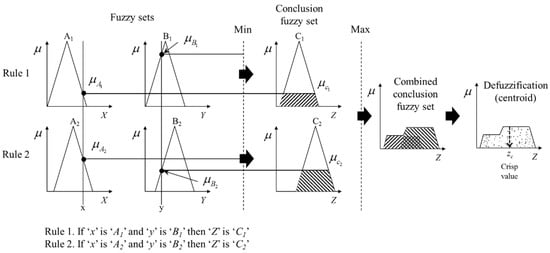
Figure 2.
Mamdani fuzzy inference system.
As expressed in Equations (2) and (3), the computational process of the fuzzy inference system simply consists of the min-max and the defuzzification processes.
3. Fire Damage Diagnosis System Using Fuzzy Theory
3.1. Combined Case of Primary Damages
The fire damage diagnosis system developed in this study takes into account the inspection data on the concrete discoloration (CD), the crack width (CR), the spalling depth (SP), the heating temperature (TP), the ratio of the design-to-measured compressive strength of concrete (RCS) and the concrete carbonation depth (CA) as the input variables, as shown in Figure 1 and Table 3. Here, it is worth mentioning that the heating temperature (TP) is in fact supposed to be estimated by, for example, discoloration of concrete or other measurements, such as the UV spectrum method, microwave measurement, thermoluminescence measurement, ultrasonic test, X-ray diffraction method, etc., as listed in Table 2. The combined Case I of primary damages (CPD I) considers only the effects of the concrete discoloration, crack width and spalling depth that can be simply obtained from visual inspection without any field measurement or laboratory testing. If the damage level of the RC structures is marginal, which is pre-defined as Grade A presented in the KCI and JCI specification, as shown in Table 1, the fire damage diagnosis is then completed without additional field inspection. If the evaluation result at CPD I belongs to Grades B–E, the combined Case II of primary damages (CPD II) should be carried out to determine the fire damage grade in a more detailed manner. The CPD II considers not only the input variables used in the CPD I, but also those obtained from the field measurement or laboratory testing, such as the heating temperature, the concrete compressive strength and the concrete carbonation depth.

Table 3.
Input variable items for combined cases of primary damages (CPD I and II).
3.2. Membership Function
In order to use the input variables in the fire damage diagnosis system based on fuzzy theory, they should be fuzzified first, and the triangular and trapezoidal fuzzy sets were used in this study, as shown in Figure 3. The membership function of a triangular fuzzy set can be defined, depending on the range of the input variable (), as follows:
where , and are the constants representing the range of the input variable (), as shown in Figure 3a. In addition, the membership function of a trapezoidal fuzzy set can also be defined, as follows:
where , , and are the constants representing the range of the input variable (), as shown in Figure 3b. As shown in Figure 4, the fuzzy sets of all of the input variables were carefully constructed based on the detailed guidelines for the Safety Inspection Regulations of Korea Infrastructure Safety and Technology Corporation (KISTEC) []. In particular, the concrete discoloration status was divided into four categories: sooty, pink, light gray and concrete melting, as shown in Figure 4a, and the ranges of the heating temperature depending on the discoloration condition were determined based on the Fire Resistance of Reinforced Concrete Structures [] published by the Korea Concrete Institute (KCI).
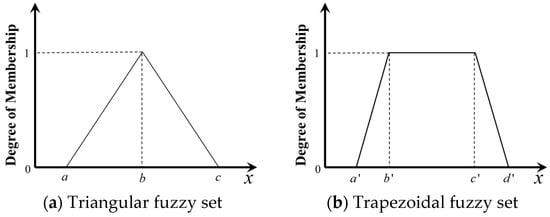
Figure 3.
Triangular and trapezoidal fuzzy sets [].
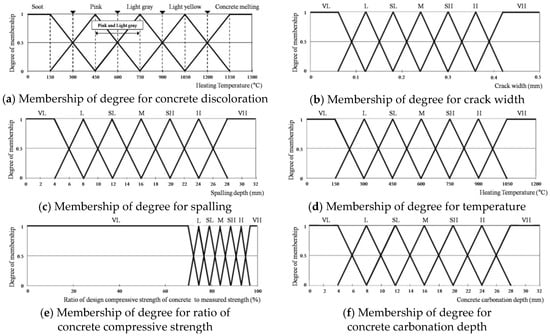
Figure 4.
Fuzzy sets of input data.
3.3. Process for CPD I
As previously mentioned, in the , the visual inspection data on the concrete discoloration (CD), the crack width (CR) and the spalling depth (SP) were utilized as the input variables. Mamdani’s fuzzy inference method [,] is used to estimate the grade of each variable expressed as A–E, and the final fire damage grade of an individual structural member is then determined by combining the grades of all of the variables.
In the process of the , the fuzzifications of the input variables are performed by substituting each visual inspection datum into the corresponding fuzzy set shown in Figure 4a–c, and the fuzzy rules are then defined as shown in Table 4, where the output fuzzy sets belong to all of the fire damage Grades A–E. For example, as shown in Figure 5, if the concrete color is observed from the visual inspection as pink, slightly affected by light-gray, and the heating temperature is estimated to be 525 °C, the membership degree of the pink is estimated to be 0.75, and that of the light gray is estimated as 0.25. The fire damage grades of the concrete discoloration can then be estimated using the predefined fuzzy rules and , for instance, as shown in Figure 6 and Table 4. Therefore, the membership degree of the concrete discoloration belongs to ‘SH (slightly-high)’ of Grade A by as much as 0.75 according to the fuzzy rule and to ‘M (medium)’ by as much as 0.25 according to the fuzzy rule . As shown in the last step of Figure 6, the possibility () of each fuzzy rule can be combined, and the possibility () of the concrete discoloration belonging to Grade A can then be estimated as 0.614 from the defuzzification process introduced in Equation (3). In addition, as shown in Figure 7, the possibility of Grades B, C, D and E for the concrete discoloration can be estimated as 0.819, 0.716, 0.546 and 0.386, respectively.

Table 4.
Fuzzy rules for input parameters.
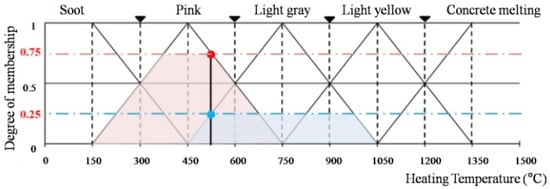
Figure 5.
An example of concrete discoloration.
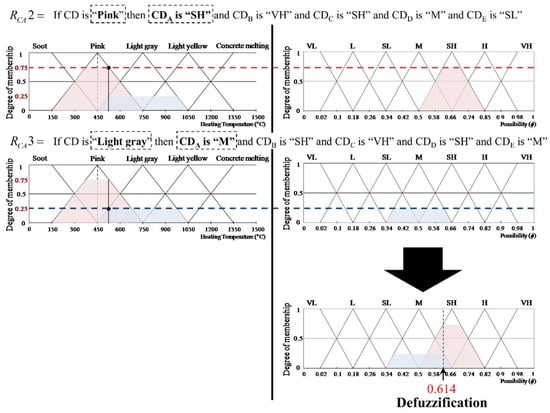
Figure 6.
Possibility of ‘A’ grade for concrete discoloration.
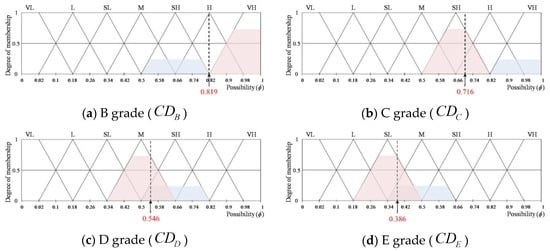
Figure 7.
Possibility of ‘B’–‘E’ grade for concrete discoloration.
In the evaluation, there are three input variable items (i.e., CD, CR and SP) and five fire damage grades (i.e., Grades A–E) for each variable item, and thus, a total of 53 (=125) fuzzy rules for output parameters should be also predefined, as shown in Figure 8. is the first fuzzy rule that is the case when the fire damage grades of all of the input variables are Grade A, while is the last fuzzy rule, which is the case when the fire damage grades of all input variables are Grade E. As in these two cases, when the grades of all of the input variables are the same (i.e., CDA, CRA and SPA), the resulting grades of their fuzzy rule can be easily determined. When the grades of the input variables are different, however, it is not easy to determine the resulting grades of the fuzzy rule, for which the weight factors should be introduced to combine the grades of the input variables. Therefore, in this study, the weight factors of the input variables were determined as shown in Table 5, based on the survey results obtained from the 72 professionals in the field of structural design and fire safety []. They were 5.0, 3.78 and 3.19 for the concrete discoloration (CD), the crack width (CR) and the spalling depth (SP), respectively, and the fire damage grade of the was then determined by the weighted average method. As shown in Figure 9, among the total 125 resulting grades, 4 of them were Grade A, 32 were Grade B, 53 were Grade C, 32 were Grade D and 4 were Grade E.
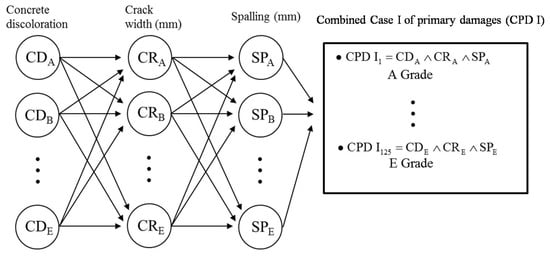
Figure 8.
Fuzzy inference process for CPD I.

Table 5.
Weight factors based on survey results from 72 professionals [].
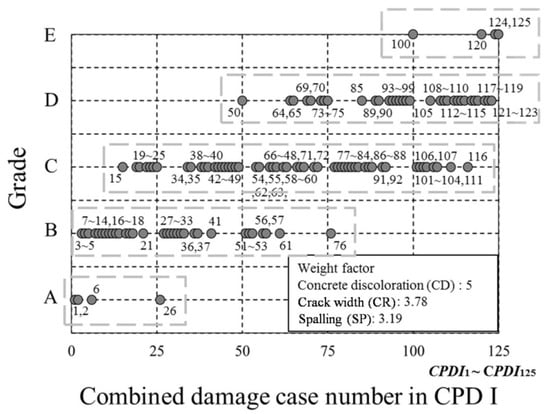
Figure 9.
Fire damage grade of .
The final fire damage grade of is determined using the min-max method. For example, if the possibility of the concrete discoloration belonging to Grade A, i.e., , is 0.5, that of the crack width belonging to Grade B, i.e., , is 0.3 and that of the spalling depth belonging to Grade C, i.e., , is 0.4, then the corresponding membership degree of the fuzzy rule, i.e., , can be estimated to be 0.3 through the min operation, as follows:
Furthermore, the fire damage grade of was determined as B by the weighted average method as shown in Figure 9. Thus, the fuzzy value can be expressed as follows:
This means that the fire damage grade of was determined as B with the possibility of 0.3. In the same way, the membership degrees of all the fuzzy values can be calculated, ranging from 1 to 125. The membership degrees of all of the grades, i.e., , , , and , can be estimated using the max operation, respectively, as follows:
The membership degree of the final fire damage grade of the , i.e., , can be then computed through the max operation, as follows:
Furthermore, the final fire damage grade of is determined as the grade that has the greatest membership degree among all of the grade membership degrees, i.e., , , , and . Thus, the fuzzy value can be expressed as follows:
where is the final fire damage grade of the RC member considered through the process. As previously mentioned, if is estimated as Grade A, no further detailed evaluation is required, and if not, the combined Case II of primary damage () evaluation needs to be conducted to determine the final fire damage grade () of the RC member.
3.4. Process for CPD II
The evaluation needs to be conducted when a more detailed assessment is required due to severe fire damages. The input variable items considered in the are the heating temperature (TP), crack width (CR), spalling depth (SP), residual strength (RCS) and concrete carbonation depth (CA). In the evaluation process, there are five input variable items and five fire damage grades for each input variable item, and thus, a total of (=3125) fuzzy rules for output parameters should be predefined as done in the , as shown in Figure 10. The weight factors of the input variables in the evaluation shown in Table 5 were also applied. Based on the same process done in , the final fire damage grade evaluation of () and its membership degree () can be obtained, and expressed in a fuzzy value form, as follows:
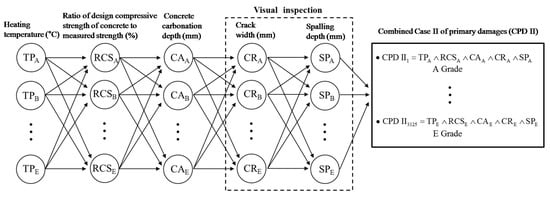
Figure 10.
Fuzzy inference process for CPD II.
4. Comparison of Evaluation Results
Table 6 shows some of the fire-damaged RC members presented in “Diagnosis and Repair Methods of Fire Damaged Buildings” published by the AIJ [,], which were obtained from the actual onsite investigation on a fire-damaged RC structure in Japan. The field inspection data of the fire-damaged RC members are also summarized in Table 6, where those are classified into two categories, i.e., CPD I and CPD II. The average compressive strength of the concrete cores taken from the columns, beams and walls in the fire-damaged area ranged from 25.1 MPa to 36.7 MPa, and those in the non-damaged area ranged from 31.9 MPa to 35.5 MPa. The measured concrete carbonation depths in the fire-damaged region ranged from 10.9 mm to 26.5 mm, and those in the non-damaged region ranged from 2.7 mm to 3.8 mm. In addition, the heating temperature was estimated at around 300 °C on average in the fire damaged region. In particular, the heating temperature was estimated at about 410 °C on the surface of Beam 2 (Case 4), which means that it was exposed to a higher temperature compared to other members, and the carbonation depth was measured at 10.9 mm. In addition, the carbonation depth of Wall 1 (Case 2) was measured at 26.5 mm, which was the largest among those of all members.

Table 6.
Inspection data of fire-damaged RC members [,].
Table 7 shows a comparison of the evaluation results estimated by professionals and those by the FDDS proposed in this study. The column (Case 1) shown in Table 6 was discolored to pink, and soot was also observed on the member surface, together with a 7 mm-depth spalling. In ‘Diagnosis and Repair Methods of Fire Damaged Buildings’ published by AIJ [,], Grade B was imposed on the fire-damaged column (Case 1), based on the field inspection data. The fire damage grade assessed by the FDDS was Grade B in both CPD I and CPD II evaluations, which is identical to that reported in the AIJ document. In addition, as shown in Table 7, the FDDS evaluation results for Cases 2–5 were also the same or very close to those estimated by the fire inspection professionals based on the AIJ methods. Therefore, it is considered that the FDDS proposed in this study can provide reasonable fire damage grades. It should be emphasized that the FDDS can provide consistent and objective evaluation results because it can ensure comprehensive considerations of the influential factors (i.e., the field inspection data) in a systematic manner based on fuzzy theory. As the FDDS provides very similar fire damage grades to the inspection method widely used in current practices, it can be now straightly adopted for the field inspection. In addition, since the application of the FDDS can improve the reliability of the fire damage grades of RC members, it can be also very useful to establish appropriate post-fire actions, such as repairing or strengthening of the fire-damaged RC members. The fire damage diagnosis system proposed in this study, however, can provide the fire damage grades of individual RC members, but it cannot give the overall fire damage grade of an RC structure at the structural level. Thus, additional research is yet necessary to extend its application to a building-level grade evaluation.

Table 7.
Fire damage diagnosis results by the fire damage diagnosis system (FDDS) and inspection professionals.
5. Conclusions
This study was aimed at establishing the new fire damage diagnosis system (FDDS), which can comprehensively consider the field inspection data in a systematic manner based on fuzzy theory and thus objectively evaluate the damage levels of RC members exposed to fire. In addition, the FDDS was applied to an actual fire-damaged case reported by the Architectural Institute of Japan [], and the resulting fire damage grades of the RC members were compared to those by inspection professionals. From this study, the following conclusions can be derived:
- The existing fire damage evaluation methods highly rely on the experience and knowledge of the inspector, and thus, it is hard to ensure the objectiveness and reliability of his/her evaluation results. The fire damage diagnosis system (FDDS) proposed in this study, however, can provide consistent and objective evaluation results because it can ensure comprehensive considerations of the field inspection data in a systematic manner based on fuzzy theory.
- The FDDS evaluation results for the fire-damaged case examined in this study were the same or very close to those estimated by the fire inspection professionals based on the AIJ methods. As the FDDS provides very similar fire damage grades to the inspection method widely used in current practices, it can be now straightly adopted to the field inspection.
- The application of the FDDS can improve the reliability of the fire damage grades of RC members; it can be also very useful to establish appropriate post-fire actions, such as repairing or strengthening of the fire-damaged RC members.
- The fire damage diagnosis system proposed in this study provides the fire damage grades of individual RC members only, but it cannot give the overall fire damage grade of an RC structure at a structural level. Thus, additional research is yet necessary to extend its application to a building-level grade evaluation.
Acknowledgments
This research was supported by the Mid-career Researcher Program through the National Research Foundation of Korea (NRF) funded by the Ministry of Education, Science and Technology (2016R1A2B2010277).
Author Contributions
All of the authors participated in developing and verifying the fire damage diagnosis system introduced in this manuscript, and the Kang Su Kim supervised this study. While Hae-Chang Cho and Kang Su Kim took the lead in writing of this paper, the second, third, fourth and fifth contributed significantly to revising and improving it.
Conflicts of Interest
The authors declare no conflict of interest.
References
- Korea Concrete Institute (KCI). Fire Resistance of Reinforced Concrete Structures; KCI: Seoul, Korea, 2005; 205p. [Google Scholar]
- Architectural Institute of Japan (AIJ). Diagnosis and Repair Methods of Fire-Damaged Buildings; AIJ: Tokyo, Japan, 2004; 140p. [Google Scholar]
- Architectural Institute of Korea (AIK). Repair and Reinforcement of Concrete Structures; AIK: Seoul, Korea, 1997; 181p. [Google Scholar]
- Kwon, Y.J.; Kim, M.H.; Kim, Y.R.; Jang, J.B. The Engineering Properties of Concrete Exposed at High Temperature. Korea Inst. Fire Sci. Eng. 2004, 18, 31–36. [Google Scholar]
- Kwon, Y.J.; Jang, J.B.; Kim, Y.R.; Kim, J.H.; Jang, J.H.; Kim, M.H. A Study on the Diagnosis and Repair Method of Deteriorated Concrete Structure by Fire Damage. Korea Inst. Fire Sci. Eng. 2003, 2003, 230–235. [Google Scholar]
- Zimmermann, H.J. Fuzzy Set Theory and Its Applications; Kluwer Academic Publishers: Dordrecht, The Netherlands, 2001; 544p. [Google Scholar]
- Ross, T.J. Fuzzy Logic with Engineering Applications; Wiley: Hoboken, NJ, USA, 2010; 632p. [Google Scholar]
- Rao, S.S.; Sunsaraju, K.; Praksah, B.G.; Balakrishna, C. Multiobjective Fuzzy Optimization Techniques for Engineering Design. Comput. Struct. 1992, 42, 37–44. [Google Scholar] [CrossRef]
- Mo, Z.G.; Kang, M.M. Structural Optimization by Fuzzy Decision Making. Archit. Inst. Korea 1997, 13, 299–308. [Google Scholar]
- Kim, Y.M.; Kim, C.K.; Hong, G.H.; Hong, S.G. Fuzzy Based Assessment for Reinforced Concrete Building Structures. Archit. Inst. Korea 2001, 17, 123–132. [Google Scholar] [CrossRef]
- Kim, Y.M.; Kim, C.K.; Hong, S.G. Fuzzy set based crack diagnosis system for reinforced concrete structures. Comput. Struct. 2007, 85, 1828–1844. [Google Scholar] [CrossRef]
- Cho, H.C.; Lee, D.H.; Ju, H.; Kim, K.S.; Kim, K.-H.; Monteiro, P.J.M. Remaining service life estimation of reinforced concrete buildings based on fuzzy approach. Comput. Concr. 2015, 15, 879–902. [Google Scholar] [CrossRef]
- Cho, H.C.; Ju, H.; Oh, J.Y.; Lee, K.J.; Hahm, K.W.; Kim, K.S. Estimation of Concrete Carbonation Depth Considering Multiple Influencing Factors on the Deterioration of Durability for Reinforced Concrete Structures. Adv. Mater. Sci. Eng. 2016, 2016, 4814609. [Google Scholar] [CrossRef]
- Zadeh, L.A. Fuzzy Sets. Inf. Control 1965, 8, 338–353. [Google Scholar] [CrossRef]
- Jang, J.S.R.; Sun, C.T.; Mizutani, E. Neuro-Fuzzy and Soft Computing; Prentice Hall: Upper Saddle River, NJ, USA, 1997; 614p. [Google Scholar]
- Mamdani, E.H.; Assilina, S. An Experiment in Linguistic Synthesis with a Fuzzy Logic Controller. Int. J. Man-Mach. Stud. 1975, 7, 1–13. [Google Scholar] [CrossRef]
- Jo, H. Fuzzy Based Condition Assessment Model of Middle and Small-Size Buildings. Master’s Thesis, Incheon National University, Incheon, Korea, 2011; 111p. [Google Scholar]
- Korea Infrastructure Safety and Technology Corporation (KISTEC). Safety Inspection Regulations; Ministry of Land, Transport and Maritime Affairs: Sejong, Korea, 2009; 202p. [Google Scholar]
- Kim, S.B.; Choi, S.G.; Han, S.H. Diagnosis and Repair Methods of Fire Damaged Buildings; Kimoondang: Soeul, Korea, 2009; 207p. [Google Scholar]
© 2017 by the authors. Licensee MDPI, Basel, Switzerland. This article is an open access article distributed under the terms and conditions of the Creative Commons Attribution (CC BY) license (http://creativecommons.org/licenses/by/4.0/).